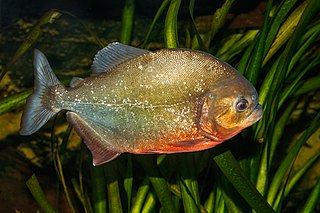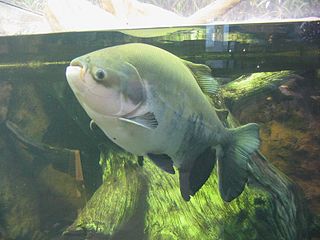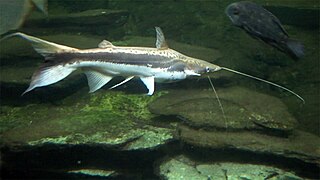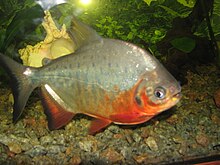
Characidae, the characids or characins is a family of freshwater subtropical and tropical fish, belonging to the order Characiformes. The name "characins" is the historical one, but scientists today tend to prefer "characids" to reflect their status as a by and large monophyletic group at family rank. To arrive there, this family has undergone much systematic and taxonomic change. Among those fishes that remain in the Characidae for the time being are the tetras, comprising the very similar genera Hemigrammus and Hyphessobrycon, as well as a few related forms such as the cave and neon tetras. Fish of this family are important as food and also include popular aquarium fish species.

A piranha or piraña, a member of family Serrasalmidae, or a member of the subfamily Serrasalminae within the tetra family, Characidae in order Characiformes. They are freshwater fish that inhabit South American rivers, floodplains, lakes and reservoirs. Although often described as extremely predatory and mainly feeding on fish, their dietary habits vary extensively, and they will also take plant material, leading to their classification as omnivorous.

Piaractus mesopotamicus, the small-scaled pacu, Paraná River pacu or simply pacu, is a South American ray-finned fish that is native to the Paraguay-Paraná River basin, but it has been introduced by aquaculture activities in a wider area. In its native range it is also known as the pacú chato, pez chato or mbiraí-piraí.

Pacu is a common name used to refer to several species of omnivorous South American freshwater serrasalmid fish that are related to the piranha. Pacu and piranha do not have similar teeth, the main difference being jaw alignment; piranha have pointed, razor-sharp teeth in a pronounced underbite, whereas pacu have squarer, straighter teeth and a less severe underbite, or a slight overbite. Pacu, unlike piranha, mainly feed on plant material and not flesh or scales. Additionally, the pacu can reach much larger sizes than piranha, at up to 1.08 m in total length and 40 kg (88 lb) in weight.

The tambaqui is a large species of freshwater fish in the family Serrasalmidae. It is native to tropical South America, but kept in aquaculture and introduced elsewhere. It is also known by the names black pacu, black-finned pacu, giant pacu, cachama, gamitana, and sometimes as pacu.

Sorubim is a small genus of long-whiskered catfish native to tropical South America. A number of characteristics allows the differentiation of each species in the genus. Sorubim species are important food fish in South America and are highly significant to fisheries of some areas; however, harvests of these fish are not identified as much as other, more popular food fishes such as Colossoma, Arapaima, and Brachyplatystoma. Some species of this family are popular aquarium fish.

Mesonauta, the flag cichlids, is a small genus of cichlids native to the Amazon, Orinoco, Essequibo, Paraná and Paraguay basins in South America. Mesonauta is included in the subfamily Cichlasomatinae. They occur in various freshwater habitats such as streams and lakes, especially in areas with little water movement and aquatic vegetation. They are generally found in small groups that stay near the water surface. To avoid predators, adults may jump out of the water and juveniles mimic leaves.

Cavefish or cave fish is a generic term for fresh and brackish water fish adapted to life in caves and other underground habitats. Related terms are subterranean fish, troglomorphic fish, troglobitic fish, stygobitic fish, phreatic fish and hypogean fish.

Piaractus brachypomus, the pirapitinga, is a large species of pacu, a close relative of piranhas and silver dollars, in the serrasalmid family. It is native to the Amazon basin in tropical South America, but it formerly included populations in the Orinoco, which was described in 2019 as a separate species, P. orinoquensis. Additionally, P. brachypomus is widely farmed and has been introduced to other regions. In South Florida they are invasive in rivers, canals or lakes.

Seriola is a genus of ray-finned fish, with many species commonly known as amberjacks. Nine extant species are currently recognized, although these were formerly split into many more. Also, several species are currently placed in several other genera of the Carangidae that were originally described under Seriola. They are a large, carnivorous finfish popularly known for the firm texture and rich flavour of their flesh, which make them an ideal fish for aquaculture. Because specimens caught can weigh up to 41 kg (90 lb), and are powerful swimmers and hunters, they are also highly prized by sport fisherman.

Megapiranha is an extinct serrasalmid characin fish from the Late Miocene Ituzaingó Formation of Argentina, described in 2009. The type species is M. paranensis. It is thought to have been about 71 centimetres (28 in) in length and 10 kilograms (22 lb) in weight. The holotype consists only of premaxillae and a zigzag tooth row; the rest of its body is unknown. This dentition is reminiscent of both the double-row seen in pacus, and the single row seen in the teeth of modern piranhas, suggesting that M. paranensis is a transitional form. Its bite force is estimated between 1,240–4,749 N (279–1,068 lbf).

Ilisha is a genus of ray-finned fishes in the family Pristigasteridae. The genus contains 16 species. It is similar to Pellona but lacks a toothed hypo-maxilla. The genus has a worldwide distribution in tropical and subtropical coastal waters and estuaries. Some species also enter rivers, and I. amazonica and I. novacula are largely–if not entirely–restricted to tropical rivers.

Myleus is a genus of serrasalmids from South America, where found in the Amazon, Orinoco and São Francisco basins, as well as river basin of the Guiana Shield. They are found in rivers with moderately or fast-flowing water, including rapids. They are primarily herbivores, but also take some animal matter. Depending on the exact species, they reach up to 12–42 cm (0.4–1.4 ft) in standard length, and the adult males have a double-lobed anal fin and filamentous extensions on the dorsal fin. Their strong teeth means that larger individuals can inflict severe bites on humans.

Myloplus is a genus of freshwater fish in the family Serrasalmidae found in tropical and subtropical South America, where they inhabit rivers and streams. They are primarily herbivores, but also take some animal matter. Depending on the exact species, they reach up to 16–56 cm (0.5–1.8 ft) in standard length. Adult males have a double-lobed anal fin and filamentous extensions on the dorsal fin, and both sexes can be brightly colored when breeding.

Mylossoma is a genus of serrasalmids from tropical and subtropical South America, including the basins of the Amazon, Orinoco, Lake Maracaibo and Paraguay-Paraná. These common fish are found both in main river sections and floodplains. They support important fisheries and based on a review by IBAMA, they are the seventh most caught fish by weight in the Brazilian Amazon. They primarily feed on plant material such as seeds and fruits, and in their ecology they generally resemble the larger tambaqui. Mylossoma reach up to 28.5 cm (11.2 in) in length and 1 kg (2.2 lb) in weight.
Tometes is a genus of fish in the family Serrasalmidae found in fast-flowing rivers in northern South America. Adults of all seven species in this genus are phytophagous, feeding primarily on aquatic plants in the family Podostemaceae.
The northern New Guinea giant softshell turtle is a species of turtle found in the lowlands of northern New Guinea. South of the Central Range it is replaced by the closely related southern New Guinea giant softshell turtle. It is threatened by overhunting and harvesting of eggs as well as significant habitat loss of aquatic vegetation due to introduced fish species such as the red-bellied pacu.

Coptodon is a genus of cichlids native to fresh, brackish and coastal marine waters in Africa with C. zillii also found in the Middle East. It is the only genus in the tribe Coptodonini. Formerly included in Tilapia, this genus and tribe was separated in 2013. Despite the change in genus, Coptodon spp. are still referred to by the common name tilapia. Several species are important in local fisheries and a few are aquacultured.

Krobia is a genus of cichlid fish native to freshwater habitats in South America, with three species found in the Guianas and a single in the Xingu River basin. They are typically found in small streams or creeks with little current and they feed on small invertebrates. They reach up to 12.8 cm (5.0 in) in standard length. They were formerly included in Aequidens.

Prosanta Chakrabarty is an American ichthyologist and professor of ichthyology, evolution and systematics at Louisiana State University. He studied at McGill University where he received a bachelor of science in Applied Zoology and at the University of Michigan where he obtained his PhD in Ecology and Evolution. Among other professional positions he was a Program Director for the National Science Foundation and is currently the President-Elect of the American Society of Ichthyologist and Herpetologist. He was named a TED Fellow in 2016, and a TED Senior Fellow in 2018. He was named an Elected Fellow of the AAAS for "distinguished contributions to evolutionary biology, focusing on the bioluminescent systems and historical biogeography of freshwater fishes, and for effectively communicating science to the public."


















